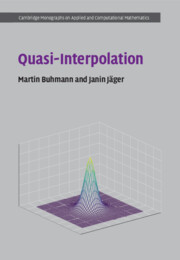Refine search
Actions for selected content:
2540 results in Computational Science
6 - Multivariate Spline Quasi-Interpolants
-
- Book:
- Quasi-Interpolation
- Published online:
- 24 February 2022
- Print publication:
- 03 March 2022, pp 106-142
-
- Chapter
- Export citation
8 - Quasi-Interpolation on the Sphere
-
- Book:
- Quasi-Interpolation
- Published online:
- 24 February 2022
- Print publication:
- 03 March 2022, pp 171-187
-
- Chapter
- Export citation
10 - Special Cases and Applications
-
- Book:
- Quasi-Interpolation
- Published online:
- 24 February 2022
- Print publication:
- 03 March 2022, pp 226-265
-
- Chapter
- Export citation
Preface
-
- Book:
- Quasi-Interpolation
- Published online:
- 24 February 2022
- Print publication:
- 03 March 2022, pp xi-xiv
-
- Chapter
- Export citation
References
-
- Book:
- Quasi-Interpolation
- Published online:
- 24 February 2022
- Print publication:
- 03 March 2022, pp 266-273
-
- Chapter
- Export citation
2 - Generalities on Quasi-Interpolation
-
- Book:
- Quasi-Interpolation
- Published online:
- 24 February 2022
- Print publication:
- 03 March 2022, pp 6-25
-
- Chapter
- Export citation
4 - Spline Quasi-Interpolants
-
- Book:
- Quasi-Interpolation
- Published online:
- 24 February 2022
- Print publication:
- 03 March 2022, pp 38-75
-
- Chapter
- Export citation
1 - Introduction
-
- Book:
- Quasi-Interpolation
- Published online:
- 24 February 2022
- Print publication:
- 03 March 2022, pp 1-5
-
- Chapter
- Export citation
Frontmatter
-
- Book:
- Quasi-Interpolation
- Published online:
- 24 February 2022
- Print publication:
- 03 March 2022, pp i-iv
-
- Chapter
- Export citation
9 - Other Quasi-Interpolants and Wavelets
-
- Book:
- Quasi-Interpolation
- Published online:
- 24 February 2022
- Print publication:
- 03 March 2022, pp 188-225
-
- Chapter
- Export citation
7 - Multivariate Quasi-Interpolants: Construction in n Dimensions
-
- Book:
- Quasi-Interpolation
- Published online:
- 24 February 2022
- Print publication:
- 03 March 2022, pp 143-170
-
- Chapter
- Export citation

Quasi-Interpolation
-
- Published online:
- 24 February 2022
- Print publication:
- 03 March 2022
Preface
-
- Book:
- Spaces of Measures and their Applications to Structured Population Models
- Published online:
- 24 September 2021
- Print publication:
- 07 October 2021, pp vii-viii
-
- Chapter
- Export citation
Appendix E - Differential Geometry
-
- Book:
- Spaces of Measures and their Applications to Structured Population Models
- Published online:
- 24 September 2021
- Print publication:
- 07 October 2021, pp 233-234
-
- Chapter
- Export citation
5 - Recent Developments and Future Perspectives
-
- Book:
- Spaces of Measures and their Applications to Structured Population Models
- Published online:
- 24 September 2021
- Print publication:
- 07 October 2021, pp 186-208
-
- Chapter
- Export citation
Appendix F - Measure Theory
-
- Book:
- Spaces of Measures and their Applications to Structured Population Models
- Published online:
- 24 September 2021
- Print publication:
- 07 October 2021, pp 235-241
-
- Chapter
- Export citation
Appendix B - Functional Analysis
-
- Book:
- Spaces of Measures and their Applications to Structured Population Models
- Published online:
- 24 September 2021
- Print publication:
- 07 October 2021, pp 215-219
-
- Chapter
- Export citation
Appendix C - Bounded Lipschitz and Hölder Functions
-
- Book:
- Spaces of Measures and their Applications to Structured Population Models
- Published online:
- 24 September 2021
- Print publication:
- 07 October 2021, pp 220-228
-
- Chapter
- Export citation
Appendix I - Semigroups
-
- Book:
- Spaces of Measures and their Applications to Structured Population Models
- Published online:
- 24 September 2021
- Print publication:
- 07 October 2021, pp 272-277
-
- Chapter
- Export citation
1 - Analytical Setting
-
- Book:
- Spaces of Measures and their Applications to Structured Population Models
- Published online:
- 24 September 2021
- Print publication:
- 07 October 2021, pp 10-57
-
- Chapter
- Export citation
